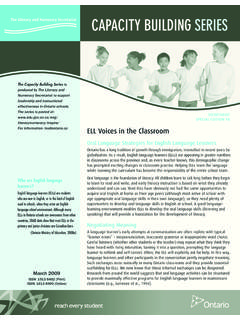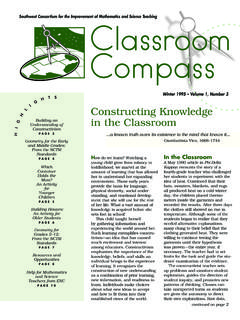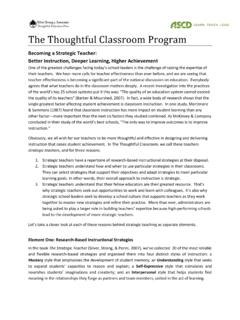Transcription of Paraprofessionals In This Issue: in Education ...
1 May/June, 1998 Volume 3, Issue 1 Aresource forfamilies and others interested inDown syndromeand This Issue: Paraprofessionals in EducationStudents with disabilities are successfully included in gen- eral Education classrooms across the country. Success is a re-sult of scheduled planning, regular meetings, discussions, and open-ness to new ideas, and tak ing time to see children as children. In these meetings and discussions the foundation for success is built. For instance, when thinking about including a student with a disability in a general Education classroom , the most common first response is to envision all the fears, barriers, and problems that may arise. However, when the team, including parents, takes time to discuss what they know about the student, the picture begins to change.
2 Each member provides a new piece to the puzzle about that student, allowing the group to see how much is already known and how to make this ex-perience a success. Some of the following ideas may assist parents and professionals to build a team that puts children first through com-munication, planning together, and finding ways to support each other no matter what difficulties arise. Role of the ParaprofessionalAs the team plans, they may decide that a student needs a paraprofessional to support the classroom teacher and the student. Paraprofessionals , or educational assistants, are important members of the Education team. When a para-professional is assigned to a teacher by Patti McVayParaprofessionals in the classroom :What Role Do They Play?
3 Paraprofessionals in the ClassroomFrom the Editor:It s IEP SeasonM y Child Has a New It Doesn t Resemble Her!ResourcesCreate-A-Team!Design Your Team Meet-ingResearch Opportunity:Healthy Lifestyles inin Down Syndrome:What Do We Know?Continued on page 3 125910131415 Disability Solutions2 Volume 3, Issue 1from the editorGrowing up, I thought there were four seasons in a year: fall, winter, spring, and I ve decided, however, that for families of kids with special needs there are not four, but five seasons in a year: fall, winter, spring, IEP, and summer. During the late spring, parents and professionals share stories of the myriad of IEP meet-ings across the nation. Some go pleasantly and others sound like the beginnings of war.
4 This year, along with the usual mix, I experienced a new twist to IEP season (no, not El Nino). The authors who contributed articles to this issue of Disability Solutions shared with me their knowledge regarding Paraprofessionals , as well as their dreams of what an inclusive classroom and community look like. They spoke of Paraprofessionals working with every student and serving as the extra set of hands all teachers need. They described situations where students willingly par-ticipate in supporting their classmate with special needs by adapting activities or providing prompts to guide their friend. But, I thought, if the students take on those tasks, won t the classroom lose the paraprofessional? Maybe, but probably not.
5 If classmates begin to provide natural prompts, it allows the paraprofessional to focus on other tasks such as creating the materials needed for an upcoming lesson the teacher has designed. One success (reducing the prompt needed from adults) leads to another (more time for creative planning).Most importantly, both Mary Beth Doyle and Patti McVay feel clear commu-nication and brainstorming by the team is essential to the success of students in inclusive settings and any other setting. Regular team meetings, clear expecta-tions of each other, and mutual respect promote creative planning and success for all students. As schools implement IDEA 97, parents will become a more frequent addition to the planning team.
6 We will, however, be among the newest to this experience. It is imperative that we foster open communication and avoid con-frontational situations when meeting to plan and brainstorm for our children. To prepare yourself and the rest of the team for this, I challenge you to complete the Create-A-Team! and Dream Your Team Meeting exercises provided by Mary Beth Doyle. I think you will find it an enlightening process. One that will dissolve any barriers that exist between members of the team. Now that I think about it, there are six seasons: fall, winter, spring, IEP, summer, and implementing the IEP, which never ends. Parents have asked to be a part of the team for a long time. Now that the opportunity is built into IDEA 97 for us, will we live up to the responsibility?
7 I hope so!Warmest regards,It s Season.. May/June, 19983 Disability Solutionsor classroom to assist students with special needs, it is crucial that they are viewed as a support for all students. This encourages and allows the teacher to take ownership for every student in the class. It also provides the teacher and all students an opportu-nity for extra instruction and support. Paraprofes-sionals commonly assist with tasks such as: leading small group instruction designed by the teacher, gathering materials, providing assistance for personal care and other physical needs, assisting students to complete directions given by the teacher, facilitating interactions between students, adapting lessons under the teacher s guidance, and executing other, often unseen, but very impor-tant tasks for the classroom the complexity of classrooms change, the role of the paraprofessional also changes.
8 With increased information and research, we can draw from estab-lished best practices for Paraprofessionals to ensure quality instruction for students. These best practices include all the activities listed above as well as an increasing role in the student-centered team. Paraprofessionals are a great asset to the educa-tional team, but there are some constraints on the responsibilities they can and should have. By law, a paraprofessional or Education assistant cannot: write programs without supervision of certified personnel, create new, alternative instruction without direc-tion from the teacher or other certified person-nel, implement behavior ideas without direction of the teacher or other certified personnel, or take complete responsibility for any when the role of the paraprofessional is unclear, they may actually be a barrier to student learning (see My Child Has A New And It Doesn t Resemble Her!)
9 Page 5). It is helpful if the paraprofessional continually asks the following question while assisting a student: Is this some-thing a classmate, buddy, or peer tutor could be doing rather than me? Can this student be success-ful with less assistance overall? Often parents will advocate for the presence of a full-time paraprofessional out of concern for their child s success. It is important to discuss the role of the paraprofessional several times each year. If a student can be successful in the classroom once peer supports are developed, the role of the paraprofessional changes. For some students the paraprofessional will continue to be a necessity. However, their direct interaction with the student should lessen over time as natural supports and accommodations are developed and the student learns the classroom RelationshipThe relationship between the classroom teacher and the paraprofessional, along with their interac-tion with the rest of the team, is the key to suc-cess for students in any learning environment.
10 It is working together that builds success. Here are some characteristics of a successful, growing team, particularly the teacher and paraprofessional rela-tionship within that team: Time together in planned regular meetings. Initially these meetings will focus on learning to work together with the student(s). Later, the discussions will focus on problem-solving, brainstorming, and, most of all, celebrating the successes. When building the student s success is the focus of the team, there is a lot to in the classroom :What Role Do They Play?Continued on page 4 Continued from page 1 Disability Solutions4 Volume 3, Issue 1 Teachers take ownership for all the students in their classroom by interacting, teaching, talking, and having fun with every student.






